Molecular and Potential Regulatory Mechanisms of Melanin Synthesis in Harmonia axyridis
Abstract
1. Introduction
2. Results
2.1. Developmental Stage Expression Patterns of HaTH
2.2. The Melanin Synthesis Pathway in H. axyridis
2.3. The Critical Period of Melanin Synthesis in H. axyridis
2.4. The Regulatory Mechanism of Transcription Factor Pannier on Melanin Synthesis in H. axyridis
3. Discussion
3.1. TH Has a Pleiotropic Role in the Development of H. axyridis
3.2. Melanin in H. axyridis Is Synthetized from Dopamine
3.3. The Crucial Synthesis time of Dopamine Melanin Precursor in H. axyridis
3.4. The Regulation Mechanism of Pannier on Melanin Synthesis in H. axyridis
4. Materials and Methods
4.1. Insects
4.2. Total RNA Isolation and cDNA Synthesis
4.3. Developmental Stage Expression profiles of HaTH
4.4. Synthesis of Double-stranded RNA (dsRNA)
4.5. RNAi Experiments
4.6. Analysis of Expression Profiles by Reverse Transcription Quantitative PCR
4.7. Image Processing
4.8. Statistical Analysis
5. Conclusions
Author Contributions
Funding
Conflicts of Interest
References
- Koch, R.L. The multicolored asian lady beetle, Harmonia axyridis: A review if its biology, uses in biological control, and non-target impacts. J. Insect Sci. 2003, 3, 32. [Google Scholar] [CrossRef] [PubMed]
- Gautier, M.; Yamaguchi, J.; Foucaud, J.; Loiseau, A.; Ausset, A.; Facon, B.; Gschloessl, B.; Lagnel, J.; Loire, E.; Parrinello, H.; et al. The genomic basis of color pattern polymorphism in the harlequin ladybird. Curr. Biol. 2018, 28, 3296–3302. [Google Scholar] [CrossRef] [PubMed]
- Anto, T.; Matsuda, T.; Goto, K.; Hara, K.; Ito, A.; Hirata, J.; Yatomi, J.; Kajitani, R.; Okuno, M.; Yamaguchi, K.; et al. Repeated inversions within a pannier intron drive diversification of intraspecific colour patterns of ladybird beetles. Nat. Commun. 2018, 9, 3843. [Google Scholar] [CrossRef] [PubMed]
- Bezzerides, A.L.; mCgraw, K.J.; Parker, R.S.; Husseini, J. Elytra color as a signal of chemical defense in the Asian ladybird beetle Harmonia axyridis. Behav. Ecol. Sociobiol. 2007, 61, 1401–1408. [Google Scholar] [CrossRef]
- Soares, A.O.; Coderre, D.; Schanderl, H. Fitness of two ohenotypes of Harmonia axyridis (Coleoptera: Coccinellidae). Eur. J. Entomol. 2001, 98, 287–293. [Google Scholar] [CrossRef]
- Soares, A.O.; Coderre, D.; Schanderl, H. Influence of prey quality on the fitness of two phenotypes of Harmonia axyridis adults. Entomol. Exp. Appl. 2005, 114, 227–232. [Google Scholar] [CrossRef]
- Chen, X.; Xiao, D.; Du, X.; Zhang, F.; Zang, L.; Wang, S. Impact of polymorphism and abiotic conditions on prey consumption by Harmonia axyridis. Entomol. Gen. 2019, 39, 251–258. [Google Scholar] [CrossRef]
- Seo, M.J.; Kim, G.H.; Youn, Y.N. Differences in biological and behavioural characteristics of Harmonia axyridis (Coleoptera: Coccinellidae) according to colour patterns of elytra. J. Appl. Entomol. 2008, 132, 239–247. [Google Scholar] [CrossRef]
- Wang, S.; Michaud, J.P.; Tan, X.L.; Zhang, F.; Guo, X.J. The aggregation behavior of Harmonia axyridis in its native range in northeast China. BioControl 2011, 56, 193–206. [Google Scholar] [CrossRef]
- Wang, S.; Michaud., J.P.; Zhang, R.Z.; Zhang, F. Seasonal cycles of assortative mating and reproductive hebaviour in polymorphic populations of Harmonia axyridis in China. Ecol. Entomol. 2009, 34, 483–494. [Google Scholar] [CrossRef]
- Wang, S.; Michaud, J.P.; Tan, X.; Murray, L.; Zhang, F. Melanism in a chinese population of Harmonia axyridis (Coleoptera: Coccinellidae): A criterion for male investment with pleiotropic effects on behavior and fertility. J. Insect. Behav. 2013, 26, 679–689. [Google Scholar] [CrossRef]
- Xiao, D.; Tan, X.; Wang, W.; Zhang, F.; Desneux, N.; Wang, S. Modification of flight and l ocomotion performances, respiratory metabolism, and trnascriptome expression in the lady beetle Harmonia axyridis through sublethal pesticide exposure. Front. Physiol. 2017, 8, 33. [Google Scholar] [CrossRef] [PubMed]
- Michie, L.J.; Mallard, F.; Majerus, M.E.N.; Jiggins, F.M. Melanic through nature or nurture: Genetic polymorphism and pehnotypic plasticity in Harmonia axyridis. J. Evol. Biol. 2010, 23, 1699–1707. [Google Scholar] [CrossRef] [PubMed]
- Michie, L.J.; Masson, A.; Ware, R.L.; Jiggins, F.M. Seasonal phenotypic plasticity: Wild ladybird are darker at cold temperature. Evol. Ecol. 2011, 25, 1259–1268. [Google Scholar] [CrossRef]
- Knapp, M.; Nedved, O. Gender and timing during ontogeny matter: Effects of a temporary high temperature on survival, body size and colouration in Harmonia axyridis. PLoS ONE 2013, 8, e74984. [Google Scholar] [CrossRef] [PubMed]
- Parchem, R.J.; Perry, M.W.; Patel, N.H. Pattern on the insect wing. Curr. Opin. Genet. Dev. 2007, 17, 300–308. [Google Scholar] [CrossRef]
- Barek, H.; Sugumaran, M.; Ito, S.; Wakamatsu, K. Insect cuticular melanins are distinctly different form those of mammalian epidermal melanins. Pigment Cell Melanoma Res. 2017, 31, 384–392. [Google Scholar] [CrossRef]
- Sugumaran, M.; Barek, H. Critical analysis of the melanogenic pathway in insects ans higher animals. Int. J. Mol. Sci. 2016, 17, 1753. [Google Scholar] [CrossRef]
- Wittkopp, P.J.; Beldade, P. Development and evolution of insect pigmentation: Genetic mechanisms and the potential consequences of pleiotropy. Semin. Cell Dev. Biol. 2009, 20, 71. [Google Scholar] [CrossRef]
- Ito, K.; Yoshikawa, M.; Fujii, T.; Tabunoki, H.; Yooyama, T. Melanin pigmentation gives rise to balck spots on the wings of the silkworm Bombyx mori. J. Insect Physiol. 2016, 91–92, 100–106. [Google Scholar] [CrossRef]
- Whitten, M.M.A.; Coates, C.J. Re-evaluation of insect melanogenesis research: Views from the dark side. Pigment Cell Melanoma Res. 2017, 30, 386–401. [Google Scholar] [CrossRef]
- Ando, T.; Niimi, T. Development and evolution of color patterns in ladybird beetles: A case study in Harmonia axyridis. Dev. Growth Differ. 2019, 61, 1. [Google Scholar] [CrossRef] [PubMed]
- Chen, X.; Xiao, D.; Du, X.; Guo, X.; Zhang, F.; Desneux, N.; Zang, L.; Wang, S. The role of the dopamine melanin pathway in the ontogeny of elytral melanization in Harmonia axyridis. Front. Physiol. 2019, 10, 1066. [Google Scholar] [CrossRef] [PubMed]
- Arakane, Y.; Lomakin, J.; Beeman, R.W.; Muthukrishnan, S.; Gehrke, S.H.; Kanost, M.R.; Kramer, K.J. Molecular and functional analyses of amino acid decarboxylases involved in cuticle tanning in Tribolium castaneum. J. Biol. Chem. 2009, 284, 16584–16594. [Google Scholar] [CrossRef]
- Fuahashi, R.; Sato, J.; Meng, Y.; Okamoto, S.; Daimon, T.; Yamamoto, K.; Suetsugu, Y.; Narukawa, J.; Takahashi, H.; Banno, Y.; et al. yellow and ebony are the responsible genes for the larval color mutants of the silkworm Bombyx mori. Genetics 2008, 180, 1995–2005. [Google Scholar] [CrossRef] [PubMed]
- True, J.R.; Edwards, K.A.; Yamamoto, D.; Carroll, S.B. Drosophila wing melanin pattern form by vein-dependent elaboration of enzymatic prepatterns. Curr. Biol. 1999, 9, 1382–1391. [Google Scholar] [CrossRef]
- Gorman, M.J.; Arakane, Y. Tyrosine hydroxylase is required for cuticle sclerotization and pigmentation in Tribilium castaneum. Insect Biochem. Mol. Biol. 2010, 40, 267–273. [Google Scholar] [CrossRef]
- Futahashi, R.; Fujiwara, H. Melanin-synthesis enzymes coregulate stage-specific larval cuticular marking in the swallowtail butterfly, Papilio xuthus. Dev. Genes Evol. 2005, 215, 519–529. [Google Scholar] [CrossRef]
- Sterkel, M.; Ons, S.; Oliveira, P.L. DOPA decarboxylase is essential for cuticle tanning in Rhodnius prolixus (Hemiptera: Reduviidae), affecting ecdysis, survival and reproduction. Insect Biochem. Mol. Biol. 2019, 108, 24–31. [Google Scholar] [CrossRef]
- Liu, J.; Lemonds, T.R.; Popadic, A. The genetic control of aposematic black pigmentation in hemimetabolous insects: Insights from Oncopeltus fasciatus. Evol. Dev. 2014, 16, 270–277. [Google Scholar] [CrossRef]
- Lemonds, T.R.; Liu, J.; Popadic, A. The contributuion of the melanin pathway to overall body pigmentation during ontogenesis of Periplaneta americana. Insect Sci. 2016, 23, 513–519. [Google Scholar] [CrossRef] [PubMed]
- Xiao, D.; Liang, X.; Gao, X.; Yao, J.; Zhu, K.Y. The lethal giant larvae gene in Tribolium castaneum: Molecular properties and roles in larval and pupal development as revealed by RNA interference. Intern. J. Mol. Sci. 2014, 15, 6880–6896. [Google Scholar] [CrossRef] [PubMed]
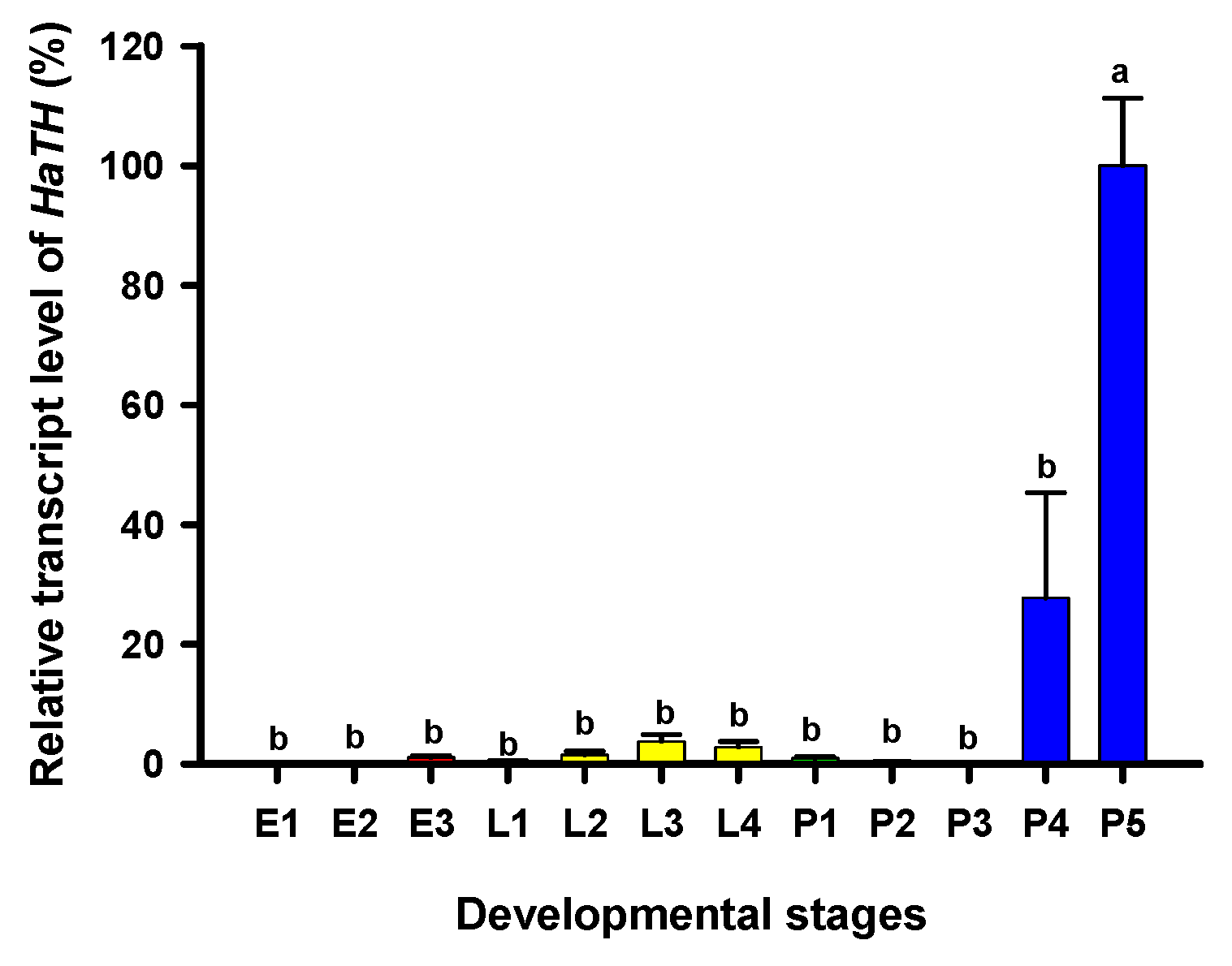
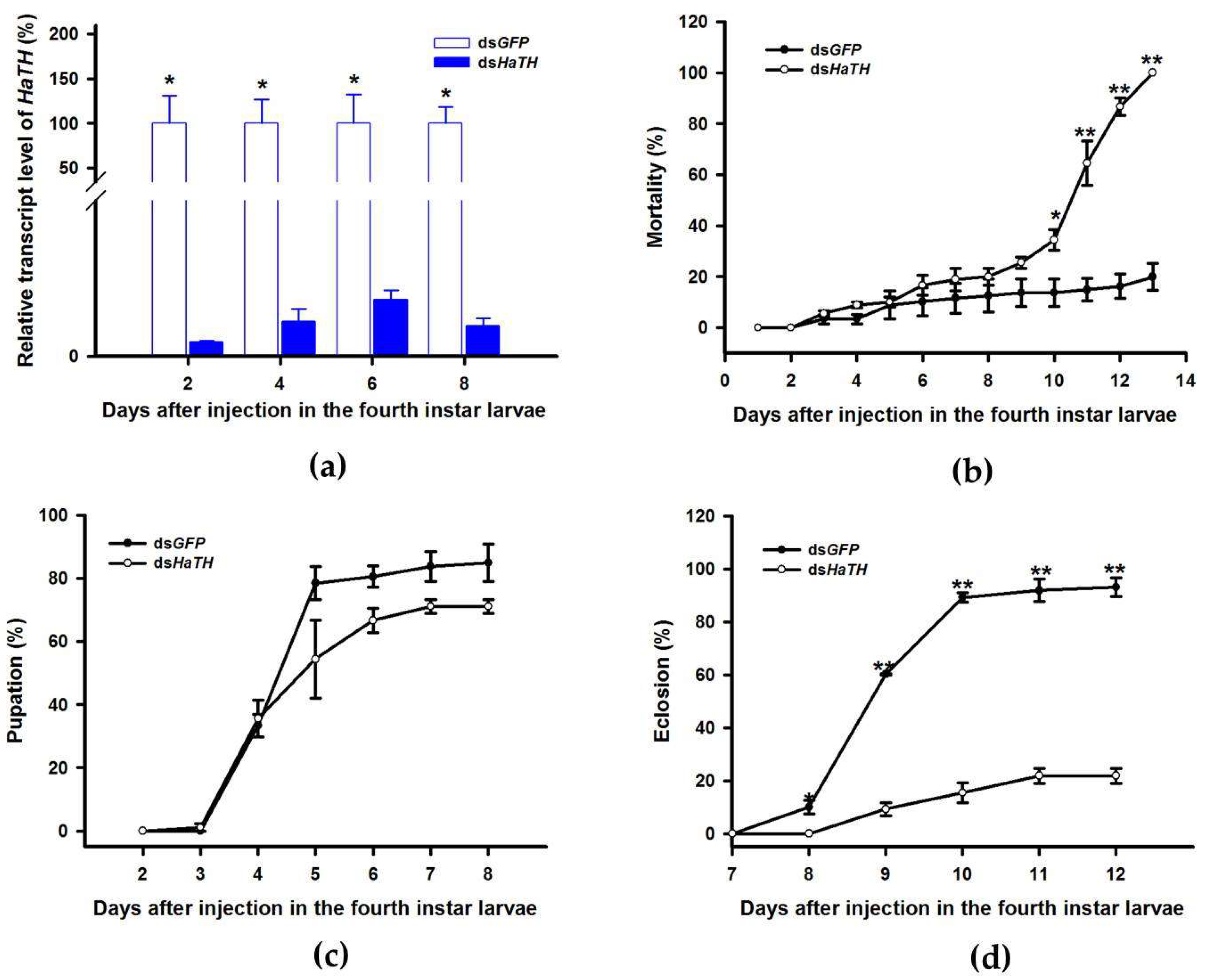
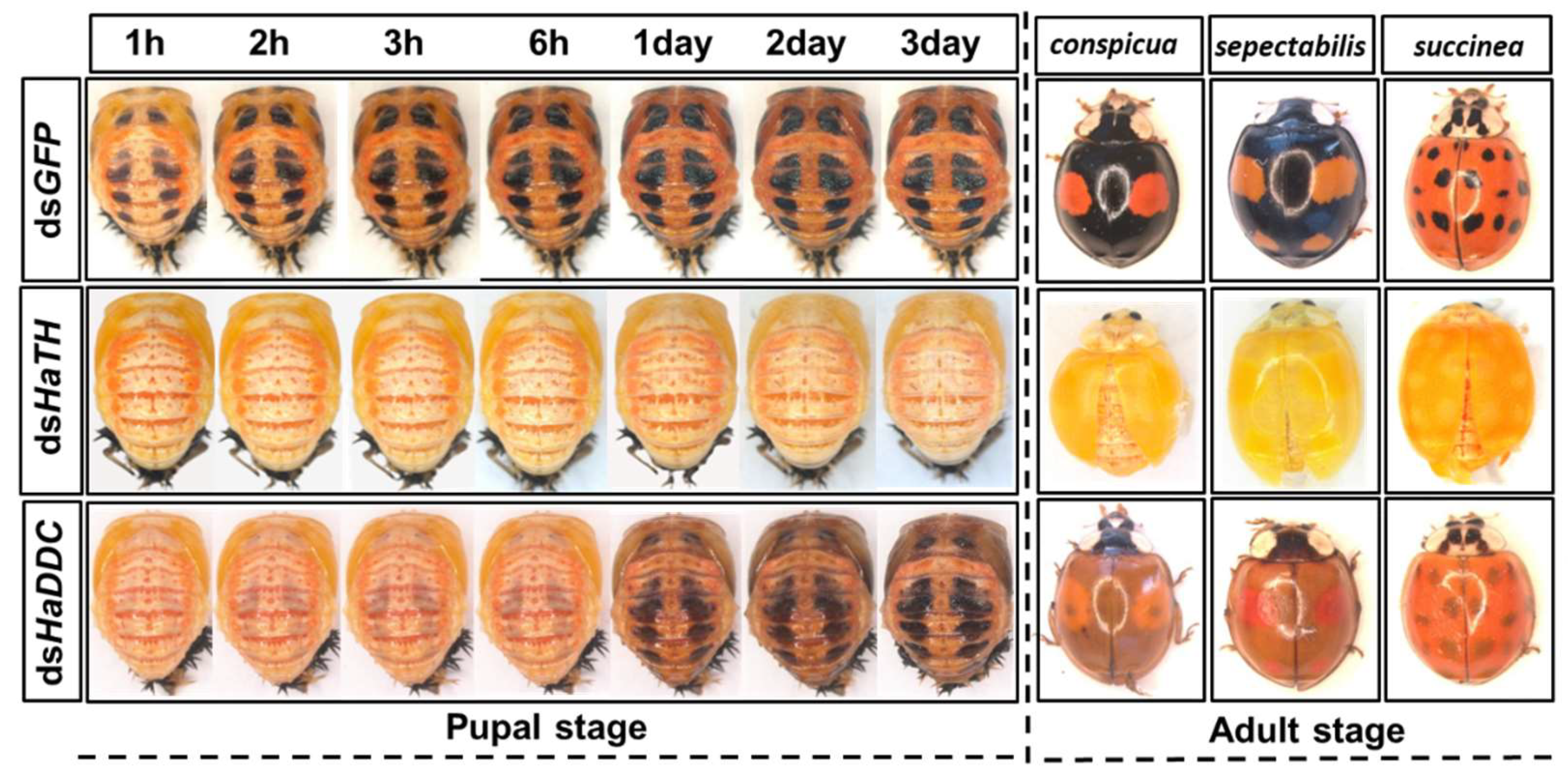
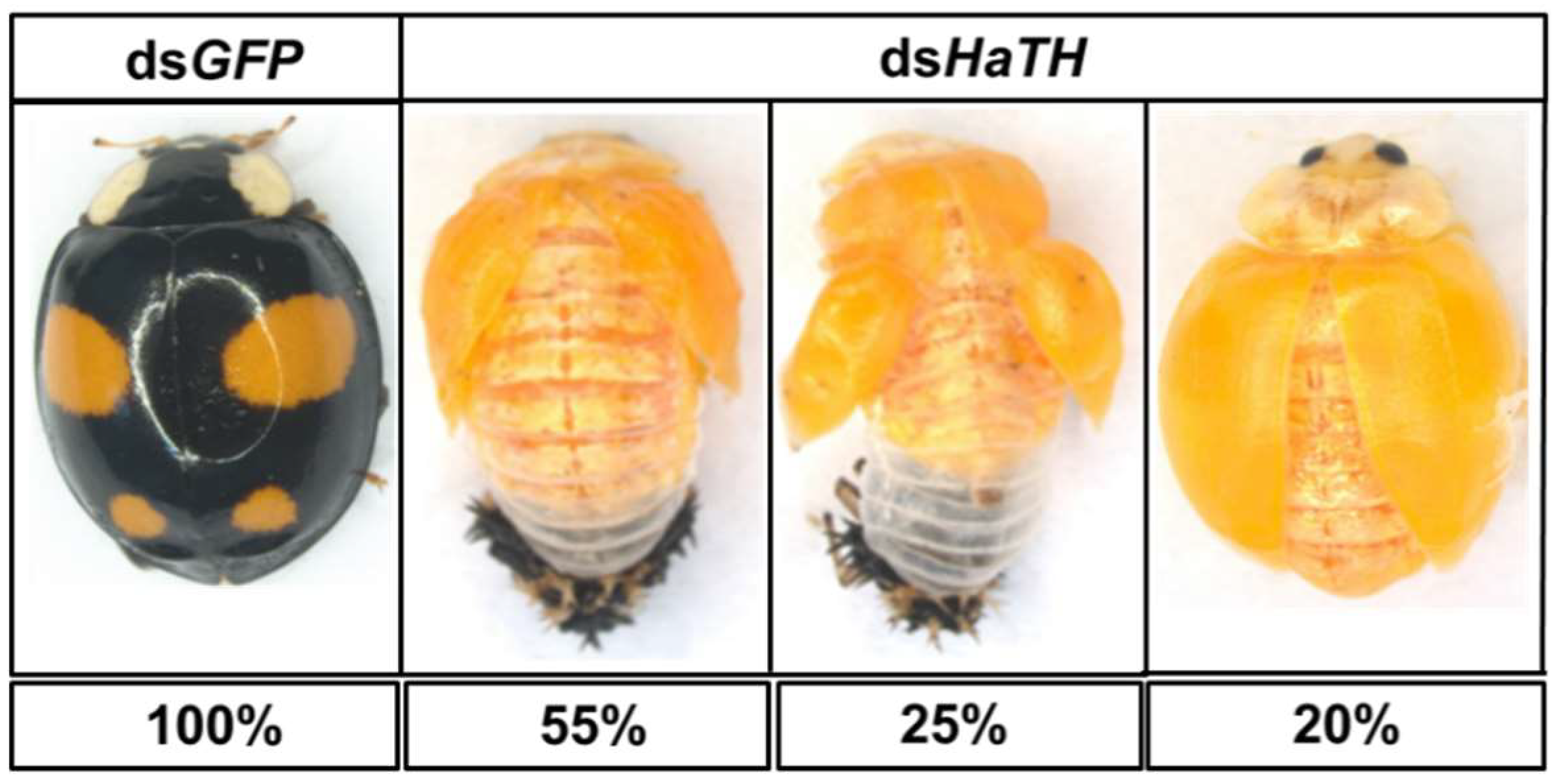
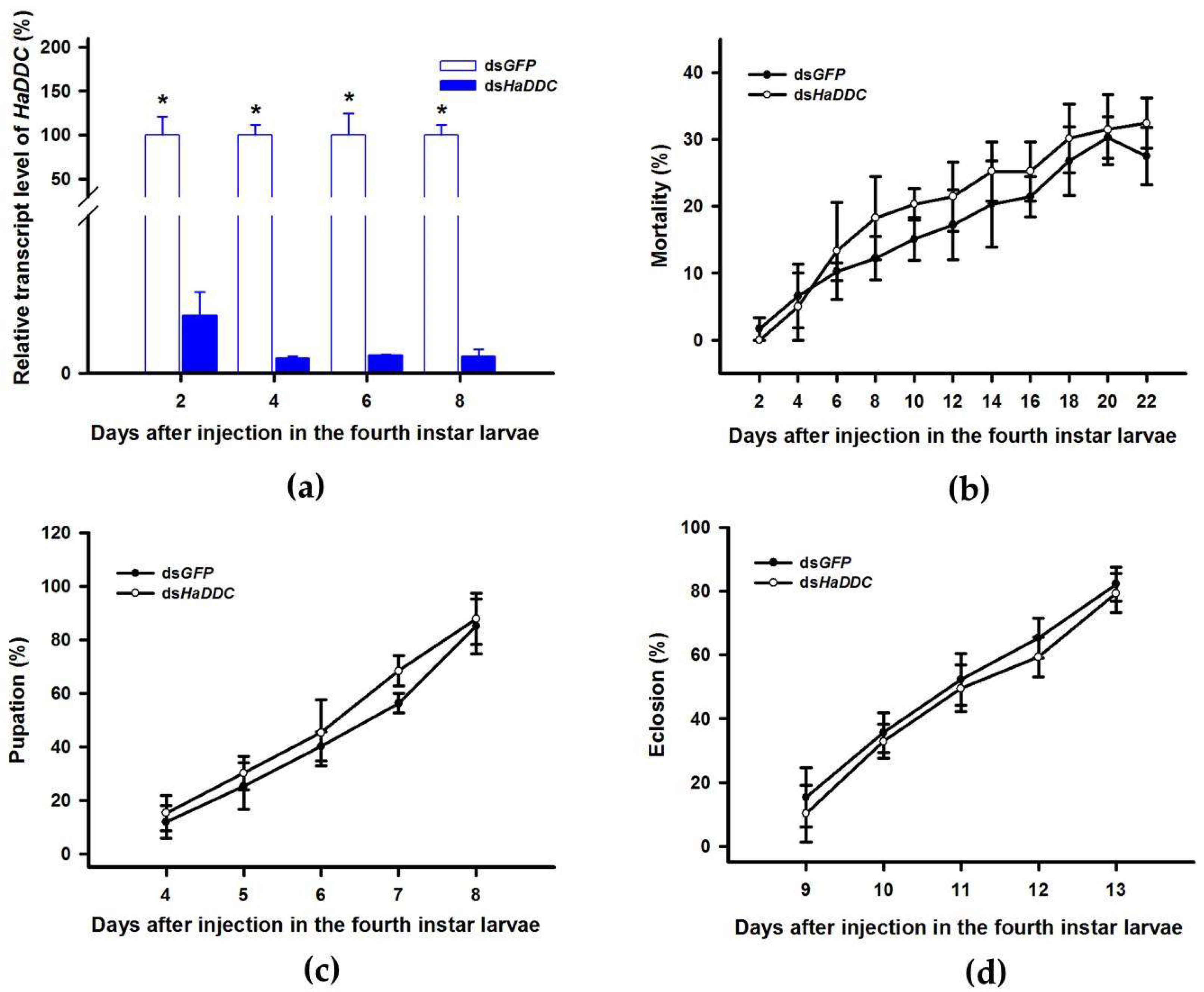
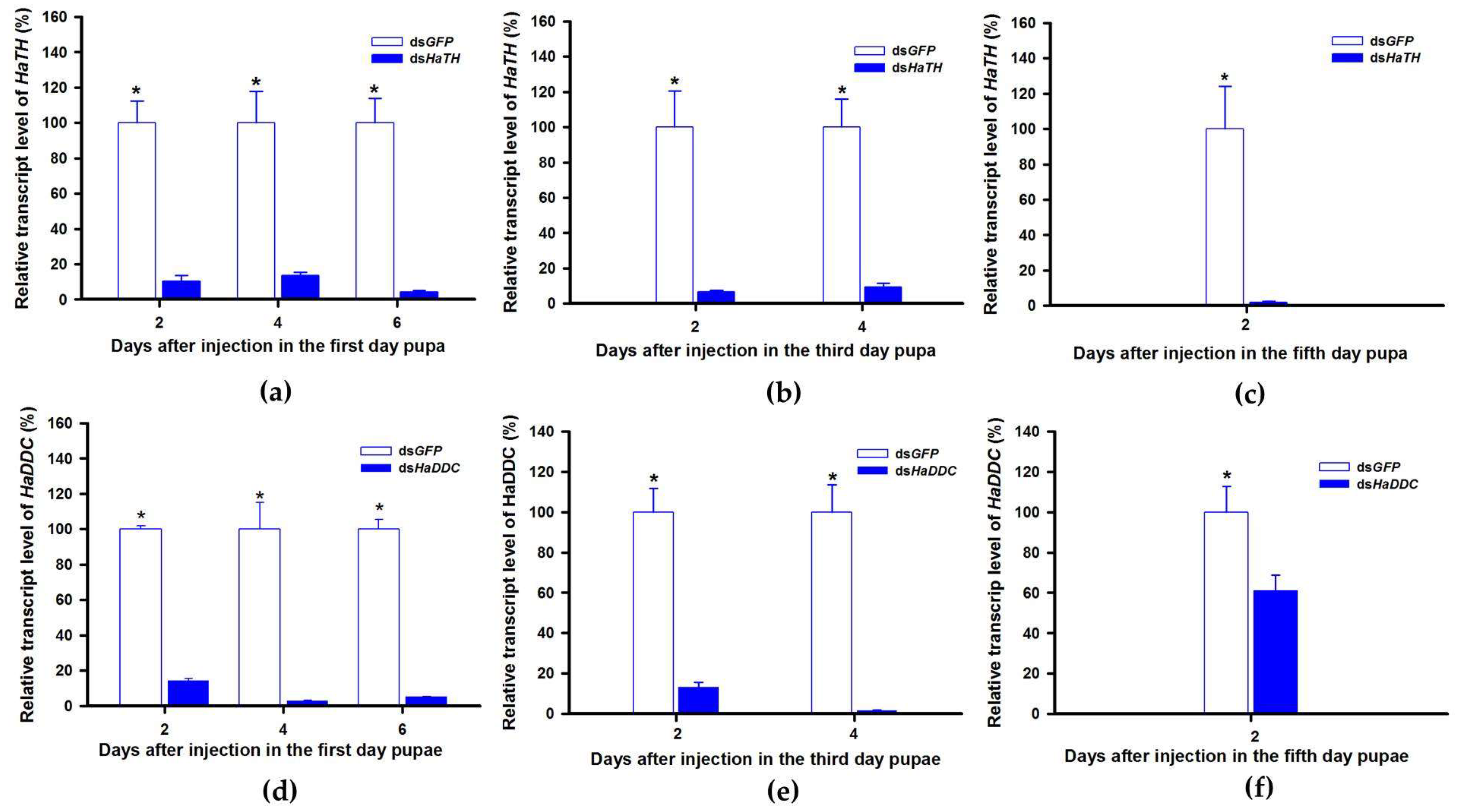

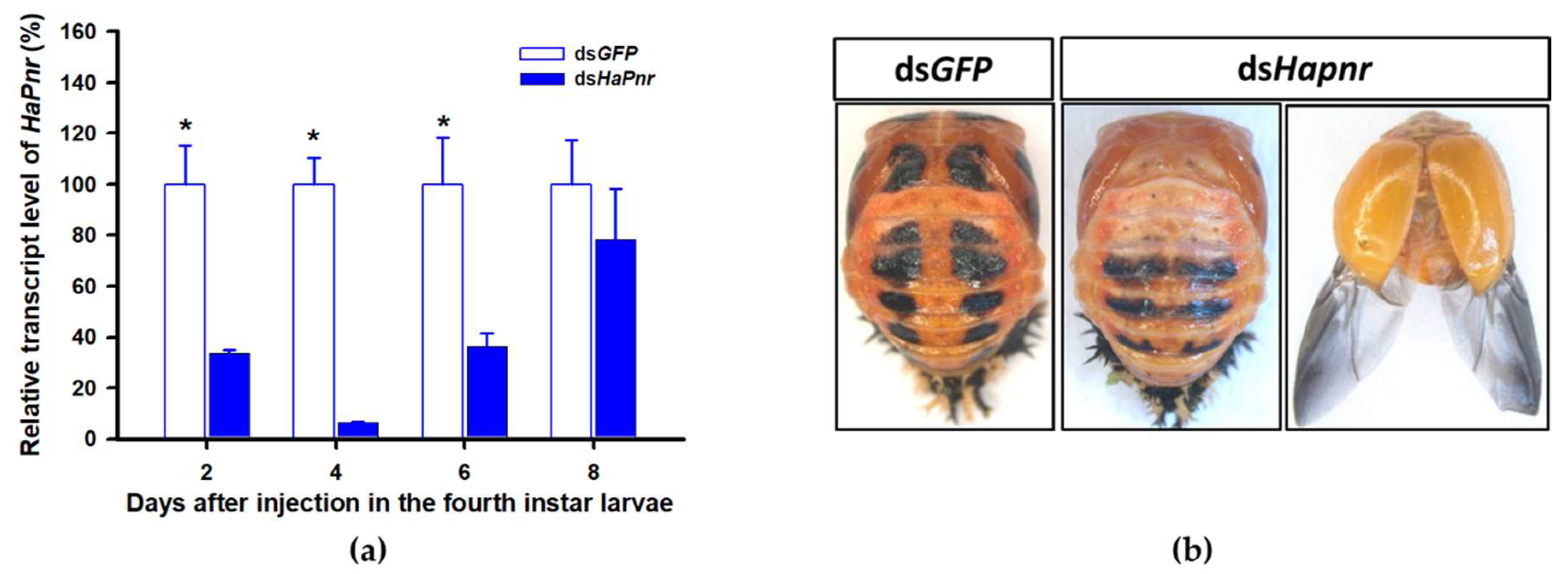

| Application of Primers | Sequence (5’-3’) | Product Length (bp) | |
|---|---|---|---|
| dsRNA synthesis | dsGFP(T7)-F | taatacgactcactatagggagaCAGTGCTTCAGCCGCTAC | 288 |
| dsGFP(T7)-R | taatacgactcactatagggagaGTTCACCTTGATGCCGTTC | ||
| dsHapnr(T7)-F | taatacgactcactatagggTACGAAAGTAACCCGTACCCC | 398 | |
| dsHapnr(T7)-R | taatacgactcactatagggGGATGGTTTTGAGATGACGAA | ||
| dsHaTH(T7)-F | taatacgactcactatagggTATCCGGCAAGAAGACGTTC | 479 | |
| dsHaTH(T7)-R | taatacgactcactatagggGTGCAATGCTCCAGAACAGA | ||
| dsHaDDC(T7)-F | taatacgactcactatagggTATAAGGGAGAGGCGGGTTT | 385 | |
| dsHaDDC(T7)-R | taatacgactcactatagggGTAGCTTCACTCGCAGTCCC | ||
| RT-qPCR | Hapnr (Q)-F | TACCCAGACCTTGGAACGAC | 135 |
| Hapnr (Q)-F | CCGAAGATTTGCTGGTAAGG | ||
| HaTH(Q)-F | GCATCTTTGCTCCTGACA | 83 | |
| HaTH(Q)-R | AGGTCTAAGGGTGAATCCA | ||
| HaDDC(Q)-F | TAGTTGCCTTGCTTGGAG | 187 | |
| HaDDC(Q)-R | TTTGATTCGTCTGTGGGTA | ||
| Harp49-F | ACGGACTTCGGTAGGACG | 130 | |
| Harp49-R | CGCAGACAATCCCGAAA |
© 2020 by the authors. Licensee MDPI, Basel, Switzerland. This article is an open access article distributed under the terms and conditions of the Creative Commons Attribution (CC BY) license (http://creativecommons.org/licenses/by/4.0/).
Share and Cite
Xiao, D.; Chen, X.; Tian, R.; Wu, M.; Zhang, F.; Zang, L.; Harwood, J.D.; Wang, S. Molecular and Potential Regulatory Mechanisms of Melanin Synthesis in Harmonia axyridis. Int. J. Mol. Sci. 2020, 21, 2088. https://doi.org/10.3390/ijms21062088
Xiao D, Chen X, Tian R, Wu M, Zhang F, Zang L, Harwood JD, Wang S. Molecular and Potential Regulatory Mechanisms of Melanin Synthesis in Harmonia axyridis. International Journal of Molecular Sciences. 2020; 21(6):2088. https://doi.org/10.3390/ijms21062088
Chicago/Turabian StyleXiao, Da, Xu Chen, Renbin Tian, Mengmeng Wu, Fan Zhang, Liansheng Zang, James D. Harwood, and Su Wang. 2020. "Molecular and Potential Regulatory Mechanisms of Melanin Synthesis in Harmonia axyridis" International Journal of Molecular Sciences 21, no. 6: 2088. https://doi.org/10.3390/ijms21062088
APA StyleXiao, D., Chen, X., Tian, R., Wu, M., Zhang, F., Zang, L., Harwood, J. D., & Wang, S. (2020). Molecular and Potential Regulatory Mechanisms of Melanin Synthesis in Harmonia axyridis. International Journal of Molecular Sciences, 21(6), 2088. https://doi.org/10.3390/ijms21062088







